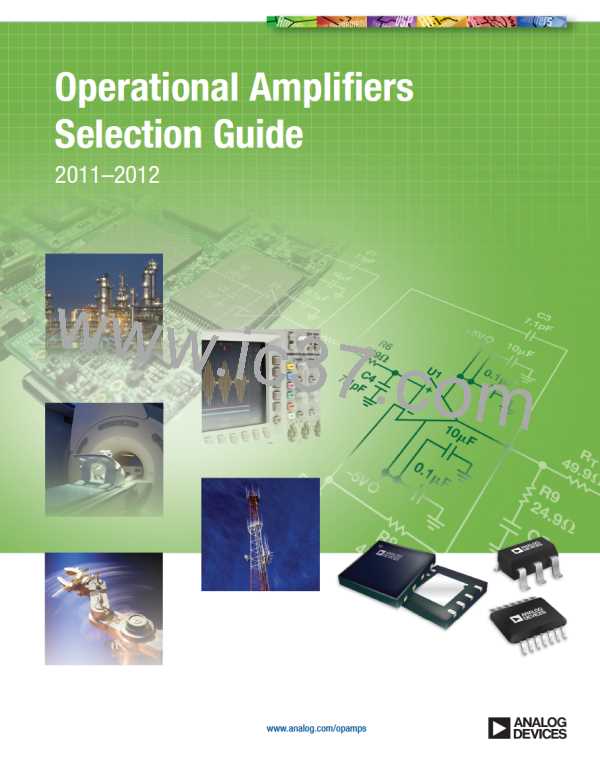Amplifier Design Technology
Clamp Amplifiers
Quad Core (H Bridge)
Clamp amplifiers allow the designer to specify a high (VCH) and low (VCL)
output clamp voltage so the output signal will clamp at the specified
levels. Analog Devices’ unique CLAMPIN™ input clamp architecture offers
significant improvement in clamp performance compared to traditional
output clamping devices, minimizing clamp error and distortion in the
clamp region.
Analog Devices has patented the quad core architecture, which supplies
current on-demand to charge and discharge the internal dominant pole
capacitor, while allowing the quiescent current to be small. This patented
architecture enables amplifiers to provide high slew rates with low
distortion at low supply currents.
Overvoltage Protection (OVP) Amplifiers
Common-Mode Linearized Amplifiers
An OVP amplifier is the most robust solution to protect the amplifier and
entire circuitry from outside the rail input voltages due to manufacturing
shorts, power supply timing, or human error. OVP is able to protect real
estate from various unexpected errors, which in turns save time and
money. OVP amplifiers require no external circuitry to provide protection.
Increasing the linear input range of the input stage optimizes operational
amplifier large signal distortion. This can be accomplished through the
use of architectures such as degenerated differential structures and
class AB input stages, both of which increase noise and lower precision.
An alternate method is to linearize using a common-mode structure
whose noise is rejected by the inherent differential nature of the input
stage while also maintaining such precision metrics as CMRR, PSRR, and
VOS. Analog Devices has numerous new amplifiers that now feature this
new technology and has patented the common-mode linearized input
architecture.
Zero-Drift Amplifiers
Zero-drift amplifiers dynamically correct the offset voltage to achieve
nanovolt-level offsets and extremely low offset drifts due to time and
temperature. The 1/f noise, seen as a dc error, is also removed. Zero-drift
amplifiers provide many benefits to designers, as temperature drift and
1/f noise, always nuisances in the system, are otherwise very difficult to
eliminate. In addition, zero-drift amplifiers have higher open-loop gain,
power supply rejection, and common-mode rejection as compared to
standard amplifiers; and their overall output error is less than that
obtained by a standard precision amplifier in the same configuration.
Current Feedback Amplifiers
Current feedback amplifiers are primarily used in applications that require
very high speed operation, large slew rates, and low distortion. The
fundamental concept is based on the fact that, in bipolar transistor circuits,
currents can be switched faster than voltages, all other things being equal.
Unlike voltage feedback amplifiers (VFB), CFB amplifiers do not have
balanced inputs. Instead, the noninverting input is high impedance, and
the inverting input is low impedance. The open-loop gain of the CFB is
measured in units of V (transimpedance gain) rather than V/V as for VFB
amplifiers. Also, the value of the feedback resistor plays a direct role in the
CFB’s stability. Therefore, adhering to the recommended feedback resistor
suggested in the data sheet is highly recommended.
Zero Input Crossover Distortion (ZCO) Amplifiers
Traditional rail-to-rail input amplifiers have an input stage that comprises
two differential pairs, a p-type and an n-type. During the transition of the
input common-mode voltage from the lower to the higher supply voltage,
one of the differential pairs turns off and the other turns on. This transition
causes crossover distortion. Zero input crossover distortion (ZCO) amplifiers
solve this problem by integrating an on-chip charge pump. The charge
pump increases the internal supply voltage, thus providing more headroom
to the input stage. This allows the input stage to handle a wider range of
input voltages (rail to rail) without using a second differential pair. As a
result, crossover distortion is avoided.
Differential Amplifiers
Differential amplifiers allow the process of single-ended input to
complementary differential outputs or differential inputs to differential
outputs. These amplifiers feature two separate feedback loops to control
the differential and common-mode output voltages. Analog Devices’
differential amplifiers are configured with a VOCM pin, which can be easily
adjusted for setting output common-mode voltage. This provides a
convenient solution when interfacing with analog-to-digital converters
(ADCs). ADI also offers a series of differential receiver products that
convert differential input signals to single-ended output.
www.analog.com/opamps
5
|

 ADI [ ADI ]
ADI [ ADI ]